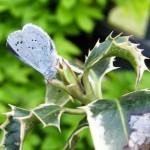I have been feeding live mealworms to the garden birds for the last couple of years and think that it is definitely paying off. Although the weather of last May apparently made it a bad year for broods of blue tits and great tits we had more than usual in our garden throughout the autumn and winter. Last year we invested in a new feeder complete with bars in order to keep the starlings out. Don’t get me wrong, I have nothing against starlings, it is just that I think they are the most intelligent of the garden birds, and they would watch and wait for the mealworms to be put out and then come and eat the lot. Even with the cage they manage to get their heads in and eat the mealworms. To this end my other half has created a modified ground feeder with the mealworms in a plastic pot on the central pole raised from the bottom, the only way to thwart these super-intelligent fiends (never fear dear reader they still get some as we leave some on the bottom of the feeder for them and they capture any escapees). See photos below for an illustration of the starling-thwarting engineered ground feeder.


Contrast this with the behaviour of the humble and incredibly blonde blue tit. Last year was the first introduction of the modified feeder – boy did they struggle. A female sparrow who had not really bothered with the feeder when it had only had seed in it was the first in, went straight to the feeder, did the blag and went off to feed her brood. For a couple of weeks she was the only taker. Eventually the blue tit figured it out, then turned psycho. It chased any bird away that it caught near the feeder, even greenfinches, and they were only taking a break between fights at the sunflower seeds.
Today the first of my multimail mealworms arrived from Wiggly Wigglers. We put them out in the modified feeder which the birds have been using all winter. The blue tit eventually figured the way in, but spent several minutes on several visits looking at the mealworms from underneath, eventually settling for a sunflower heart from another feeder and flying away each time. However, we finally had breakthrough and in record time for a blue tit it was happily murdering mealworms. Next came the great tit, another bird regularly eating mealworms from the same feeder last year. It eventually made its way in and duly sat under the pot, pecking at the worms from underneath. It then started looking under a pile of sunflower hearts for some worms (I assume it found one there earlier), then the blue tit turned up. Aha I thought, the blue tit will give it a clue, but no, the blue tit sat in the hazel for some time, watching, and probably laughing, and then nonchalantly flew to another feeder, grabbed a sunflower heart and sat in the tree to eat it. The great tit then tried hiding between the wheelie bins to tempt the blue tit down, and it nearly worked. At the last minute the blue tit saw him, pulled out and flew away, taking his secret with him. The last time I saw the great tit he still hadn’t figured it out, I guess he will get there eventually.
Blue Tit 1 Great Tit 0.

 Â I know that I could prevent this with little blue pellets, but we are trying to be as organic as possible and are trying to encourage the ecosystem (although at this rate I may start charging the frogs board and lodgings as they are not earning their keep). Â I have another courgette in reserve, but I will plant this in a pot this weekend.On the plus side, I have planted my beans in various parts of the garden, and some of them are still in one piece. Â
 I know that I could prevent this with little blue pellets, but we are trying to be as organic as possible and are trying to encourage the ecosystem (although at this rate I may start charging the frogs board and lodgings as they are not earning their keep).  I have another courgette in reserve, but I will plant this in a pot this weekend.On the plus side, I have planted my beans in various parts of the garden, and some of them are still in one piece.  








